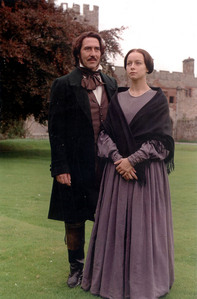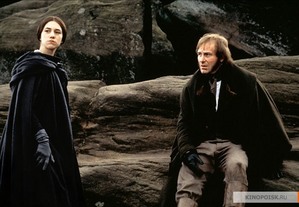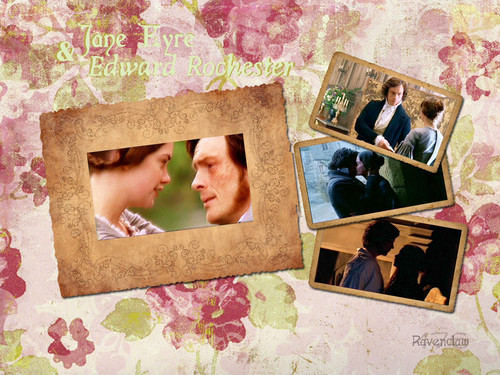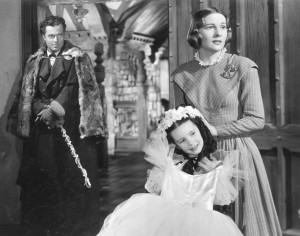"JANE EYRE" (1997) Review
There have been many adaptations of Charlotte Brontë’s 1847 novel, "Jane Eyre". And I do not exaggerate. If I must be honest, I really have no idea of the number of adaptations made. I have seen at least six of them – including his 1997 television movie that aired on the A&E Channel in the U.S. and on ITV in Great Britain.
Directed by Robert Young, and starring Samantha Morton as the titled character and Ciarán Hinds as Edward Rochester; "JANE EYRE" told the story of a young and impoverished English woman forced to become a teacher at a girls’ school in early Victorian England. Bored and dissatisfied with working at Lowood – the very school where she had also spent six years as a student, Jane Eyre places an advertisement that offers herself as a governess in a private household. A Mrs. Fairfax of Thornfield Hall responds to the advertisement and hires Jane. Upon her arrival, Jane discovers that Mrs. Fairfax is Thornfield Hall’s housekeeper and that her new student is Adèle Varens, the French-born ward of the estate’s owner, Edward Rochester. It is not long before Jane finds herself falling in love with Mr. Rochester and being drawn to a mystery surrounding him and a maleficent presence at Thornfield Hall.
Judging from the movie’s 108 minute running time, one could easily see that Richard Hawley’s screenplay had cut a great deal from Brontë’s original novel. Jane’s time at Lowood seemed rushed. Her disappointing reunion with the Reeds was completely cut out. And her time spent with St. John and Diana Rivers was censored heavily. The screenplay even failed to point out Jane’s family connections with the Rivers family and her small financial inheritance. Most of the cuts were made to fit the movie’s short running time and emphasize Jane’s relationship with Rochester. Did it work? That is a good question.
I did have some problems with this production. One hundred and eight minutes struck me as a rather short running time for an adaptation of a literary classic. Hollywood could have gotten away with such a running time during its Golden Age, but I am not so certain that it would have been able to do so, today. The movie’s limited running time was certainly apparent in its failure to depict adult Jane’s reunion with her Reed cousins. Her negative childhood in the family’s household had played an important part in Jane’s formative years. I found it ironic that Hawley’s script was willing to convey Jane’s unhappy childhood with the Reeds, but not follow up with her return to their home in the wake of a family tragedy.
This version also excluded Rochester’s barely veiled contempt toward young Adele, his ward and the daughter of his former mistress. Considering Rochester’s paternalistic attitudes and occasional sexism – conveyed in his penchant for blaming Adele for her mother’s perfidy – by ignoring his hostile attitude toward his ward, Hawley seemed to have robbed some of the landowner’s original character in order to make him more palatable. I could also say the same for Hawley and director Young’s decision to remove the incident involving Jane’s encounter with Rochester disguised as a gypsy woman. And a great deal of Jane’s stay with St. John and Diana Rivers was also deleted from this version. One, it robbed the production of an interesting peek into the St. John Rivers character. Although not a favorite of mine, I have always found him interesting. The brief focus on the Rivers sequence made the movie’s pacing within the last half hour seem rather rushed.
But Hawley’s script and Young’s direction more than made up for these shortcomings in the movie’s portrayal of Jane and Rochester’s relationship. I must admit that I found the development of their relationship fascinating to watch. I especially enjoyed how Jane managed to hold her own against Rochester’s persistent attempts to inflict his will upon her . . . earning his love and respect in the process. And in turn, Rochester manages to earn Jane’s respect and love with his intelligence, wit and gradual recognition of her virtues.
The most fascinating sequence in the entire movie was not, surprising, Rochester’s revelation of his insane wife, Bertha. Mind you, I did find that particular scene rather interesting. For me, the most fascinating scene turned out to be Rochester’s attempt to prevent Jane from leaving Thornfield Hall. He used every emotional response possible – passionate pleadings, contempt, desperation, anger and declarations of love – to get her to stay. He even suggested that she become his mistress and travel to the Continent with him in order for them to stay together. What I found amazing about his actions was his lack of remorse or regret for attempting to draw Jane into a bigamous marriage or make her his mistress. But what I found equally amazing was the fact that Jane’s love for him did not die, despite his words and actions. More importantly, she showed amazing strength by resisting him and his promises of an illicit relationship.
Aside from the movie’s writing and direction, the performances of Samantha Morton and Ciarán Hinds really drove the above mentioned scene. They were simply superb. To be honest, they gave first-rate performances throughout the entire movie. I have yet to see Ruth Wilson’s performance as Jane Eyre. But I must admit that I believe Samantha Morton gave one of the two best portrayals of the character – the other came from Zeulah Clarke in the 1983 adaptation. Morton was barely 19 or 20 when she made this film. And yet, she infused a great deal of subtle strength, warmth and passion into the role. Not only did she managed to create a strong chemistry with her leading man, but also hold her own against him, considering that he happened to be at least 24 years older than her. As for Ciarán Hinds, he also gave a first-rate performance. Mind you, there were moments when Hinds chewed the scenery . . . excessively. Perhaps that came from a theatrical style he had failed to shed for motion pictures around that time. But he did capture all aspects of Edward Rochester’s emotional make-up – both good and bad. I would not go as far to say that Ciarán Hinds was my favorite Edward Rochester. But I must admit that I found him to be a memorable one.
This movie also had the good luck to possess a solid supporting cast. However, I only found myself impressed by only a few. One of those few happened to be Timia Bertome, who portrayed young Adele. She did a very good job in not only capturing her character’s self-absorbed nature, but also Adele’s sunny disposition. Rupert Penry-Jones turned out to be a very interesting St. John Rivers. In fact, I would not hesitate to add that Penry-Jones effectively gave a new twist on the character by portraying him as a superficially friendly soul, but one who still remained arrogant, sanctimonious and pushy. It seemed a pity that the actor was never given a chance to delve even further into St. John’s character. Elizabeth Garvie, who portrayed his sister Diana, had a great deal less to do. Screenwriter Richard Hawley gave a subtle, yet effective performance as Rochester’s brother-in-law, Richard Mason. And Sophie Reissner is the first actress to make me sympathize over the plight of Rochester's mad West Indian wife, Bertha Mason Rochester. Abigail Cruttenden not only effectively portrayed the beautiful, yet vain Blanche Ingram; but also managed to inject some intelligence into the role. But my favorite supporting performance came from Gemma Jones, who portrayed Thornfield Hall’s housekeeper, Mrs. Fairfax. Superficially, she portrayed the housekeeper as a cheerful soul that kept the Rochester household running efficiently. Yet, she also conveyed Mrs. Fairfax’s anxiety and doubt over Jane’s blooming romance with Mr. Rochester and the presence in the manor’s attic with great subtlety. Jones gave the third best performance in them movie, following Morton and Hinds.
For a movie with such a short running time, I must admit that I found its production values very admirable. Cinematographer John McGlashan did an excellent job in injecting a great deal of atmosphere into his shots without allowing the movie to look too gloomy. However, I did have a problem with that slow-motion shot that featured Edward Rochester’s introduction. It seemed out of place and a bit ridiculous. Also, production designer Stephen Fineren and art director John Hill managed to maintain the movie’s atmosphere and setting. I found Susannah Buxton’s costumes surprisingly enjoyable. The costumes perfectly captured the 1830s in the film’s sequences featuring Jane’s childhood with the Reeds and at Lowood School and also the 1840s in which the rest of the movie was set. I especially have to congratulate Buxton for limiting the Jane Eyre character to only a few costumes, which seemed fitting for the character’s social and economic situation.
This version of ”JANE EYRE” was not perfect. I found its 108 minute running time too short for its story. And because of its limited running time, Richard Hawley’s script deleted or shortened certain scenes that I believe were essential to the story and the leading character. But I must admit that despite these shortcomings, I found this adaptation to be first-rate thanks to the focus upon the Jane Eyre/Edward Rochester relationship; a production design that reeked of early Victorian England and an excellent cast led by the superb Samantha Morton and Ciarán Hinds.
There have been many adaptations of Charlotte Brontë’s 1847 novel, "Jane Eyre". And I do not exaggerate. If I must be honest, I really have no idea of the number of adaptations made. I have seen at least six of them – including his 1997 television movie that aired on the A&E Channel in the U.S. and on ITV in Great Britain.
Directed by Robert Young, and starring Samantha Morton as the titled character and Ciarán Hinds as Edward Rochester; "JANE EYRE" told the story of a young and impoverished English woman forced to become a teacher at a girls’ school in early Victorian England. Bored and dissatisfied with working at Lowood – the very school where she had also spent six years as a student, Jane Eyre places an advertisement that offers herself as a governess in a private household. A Mrs. Fairfax of Thornfield Hall responds to the advertisement and hires Jane. Upon her arrival, Jane discovers that Mrs. Fairfax is Thornfield Hall’s housekeeper and that her new student is Adèle Varens, the French-born ward of the estate’s owner, Edward Rochester. It is not long before Jane finds herself falling in love with Mr. Rochester and being drawn to a mystery surrounding him and a maleficent presence at Thornfield Hall.
Judging from the movie’s 108 minute running time, one could easily see that Richard Hawley’s screenplay had cut a great deal from Brontë’s original novel. Jane’s time at Lowood seemed rushed. Her disappointing reunion with the Reeds was completely cut out. And her time spent with St. John and Diana Rivers was censored heavily. The screenplay even failed to point out Jane’s family connections with the Rivers family and her small financial inheritance. Most of the cuts were made to fit the movie’s short running time and emphasize Jane’s relationship with Rochester. Did it work? That is a good question.
I did have some problems with this production. One hundred and eight minutes struck me as a rather short running time for an adaptation of a literary classic. Hollywood could have gotten away with such a running time during its Golden Age, but I am not so certain that it would have been able to do so, today. The movie’s limited running time was certainly apparent in its failure to depict adult Jane’s reunion with her Reed cousins. Her negative childhood in the family’s household had played an important part in Jane’s formative years. I found it ironic that Hawley’s script was willing to convey Jane’s unhappy childhood with the Reeds, but not follow up with her return to their home in the wake of a family tragedy.
This version also excluded Rochester’s barely veiled contempt toward young Adele, his ward and the daughter of his former mistress. Considering Rochester’s paternalistic attitudes and occasional sexism – conveyed in his penchant for blaming Adele for her mother’s perfidy – by ignoring his hostile attitude toward his ward, Hawley seemed to have robbed some of the landowner’s original character in order to make him more palatable. I could also say the same for Hawley and director Young’s decision to remove the incident involving Jane’s encounter with Rochester disguised as a gypsy woman. And a great deal of Jane’s stay with St. John and Diana Rivers was also deleted from this version. One, it robbed the production of an interesting peek into the St. John Rivers character. Although not a favorite of mine, I have always found him interesting. The brief focus on the Rivers sequence made the movie’s pacing within the last half hour seem rather rushed.
But Hawley’s script and Young’s direction more than made up for these shortcomings in the movie’s portrayal of Jane and Rochester’s relationship. I must admit that I found the development of their relationship fascinating to watch. I especially enjoyed how Jane managed to hold her own against Rochester’s persistent attempts to inflict his will upon her . . . earning his love and respect in the process. And in turn, Rochester manages to earn Jane’s respect and love with his intelligence, wit and gradual recognition of her virtues.
The most fascinating sequence in the entire movie was not, surprising, Rochester’s revelation of his insane wife, Bertha. Mind you, I did find that particular scene rather interesting. For me, the most fascinating scene turned out to be Rochester’s attempt to prevent Jane from leaving Thornfield Hall. He used every emotional response possible – passionate pleadings, contempt, desperation, anger and declarations of love – to get her to stay. He even suggested that she become his mistress and travel to the Continent with him in order for them to stay together. What I found amazing about his actions was his lack of remorse or regret for attempting to draw Jane into a bigamous marriage or make her his mistress. But what I found equally amazing was the fact that Jane’s love for him did not die, despite his words and actions. More importantly, she showed amazing strength by resisting him and his promises of an illicit relationship.
Aside from the movie’s writing and direction, the performances of Samantha Morton and Ciarán Hinds really drove the above mentioned scene. They were simply superb. To be honest, they gave first-rate performances throughout the entire movie. I have yet to see Ruth Wilson’s performance as Jane Eyre. But I must admit that I believe Samantha Morton gave one of the two best portrayals of the character – the other came from Zeulah Clarke in the 1983 adaptation. Morton was barely 19 or 20 when she made this film. And yet, she infused a great deal of subtle strength, warmth and passion into the role. Not only did she managed to create a strong chemistry with her leading man, but also hold her own against him, considering that he happened to be at least 24 years older than her. As for Ciarán Hinds, he also gave a first-rate performance. Mind you, there were moments when Hinds chewed the scenery . . . excessively. Perhaps that came from a theatrical style he had failed to shed for motion pictures around that time. But he did capture all aspects of Edward Rochester’s emotional make-up – both good and bad. I would not go as far to say that Ciarán Hinds was my favorite Edward Rochester. But I must admit that I found him to be a memorable one.
This movie also had the good luck to possess a solid supporting cast. However, I only found myself impressed by only a few. One of those few happened to be Timia Bertome, who portrayed young Adele. She did a very good job in not only capturing her character’s self-absorbed nature, but also Adele’s sunny disposition. Rupert Penry-Jones turned out to be a very interesting St. John Rivers. In fact, I would not hesitate to add that Penry-Jones effectively gave a new twist on the character by portraying him as a superficially friendly soul, but one who still remained arrogant, sanctimonious and pushy. It seemed a pity that the actor was never given a chance to delve even further into St. John’s character. Elizabeth Garvie, who portrayed his sister Diana, had a great deal less to do. Screenwriter Richard Hawley gave a subtle, yet effective performance as Rochester’s brother-in-law, Richard Mason. And Sophie Reissner is the first actress to make me sympathize over the plight of Rochester's mad West Indian wife, Bertha Mason Rochester. Abigail Cruttenden not only effectively portrayed the beautiful, yet vain Blanche Ingram; but also managed to inject some intelligence into the role. But my favorite supporting performance came from Gemma Jones, who portrayed Thornfield Hall’s housekeeper, Mrs. Fairfax. Superficially, she portrayed the housekeeper as a cheerful soul that kept the Rochester household running efficiently. Yet, she also conveyed Mrs. Fairfax’s anxiety and doubt over Jane’s blooming romance with Mr. Rochester and the presence in the manor’s attic with great subtlety. Jones gave the third best performance in them movie, following Morton and Hinds.
For a movie with such a short running time, I must admit that I found its production values very admirable. Cinematographer John McGlashan did an excellent job in injecting a great deal of atmosphere into his shots without allowing the movie to look too gloomy. However, I did have a problem with that slow-motion shot that featured Edward Rochester’s introduction. It seemed out of place and a bit ridiculous. Also, production designer Stephen Fineren and art director John Hill managed to maintain the movie’s atmosphere and setting. I found Susannah Buxton’s costumes surprisingly enjoyable. The costumes perfectly captured the 1830s in the film’s sequences featuring Jane’s childhood with the Reeds and at Lowood School and also the 1840s in which the rest of the movie was set. I especially have to congratulate Buxton for limiting the Jane Eyre character to only a few costumes, which seemed fitting for the character’s social and economic situation.
This version of ”JANE EYRE” was not perfect. I found its 108 minute running time too short for its story. And because of its limited running time, Richard Hawley’s script deleted or shortened certain scenes that I believe were essential to the story and the leading character. But I must admit that despite these shortcomings, I found this adaptation to be first-rate thanks to the focus upon the Jane Eyre/Edward Rochester relationship; a production design that reeked of early Victorian England and an excellent cast led by the superb Samantha Morton and Ciarán Hinds.

Anyway, I love all things Jane! When I graduated from high school, my dad even managed to take me to the Broadway show that was playing for a while. I’ve read almost all the retellings and sequels I can find (besides rereading the original every so often) so I finally decided to write my own! Even if you don’t want to nominate on Amazon, you can still find a version of my story on fanfiction.net if you’d like something Eyre-related to read.
Thanks again!
Corrie Garrett















